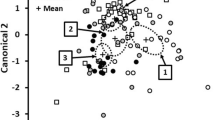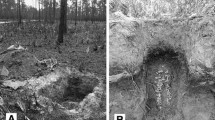Summary
We examined division of labor and colony demography in the antPonera pennsylvannica. Observation of three colonies with individually marked workers revealed a high degree of interindividual behavioral variation and a rough but consistent division of labor between brood tenders and foragers. This division was present both in colonies consisting entirely of workers produced in the previous summer and in colonies containing freshly eclosed ants. Two colonies showed typical age-based polyethism, with young ants focusing on brood care and overwintered ants on foraging. No such age basis was detected in the third colony. This difference may relate to variability in brood production schedules. Colonies showing temporal polyethism had two peaks of brood production and thus had relatively large brood populations when the first young workers eclosed, while the third colony had only one peak and little brood for the young workers to tend. Even if young ants have a lower threshold for brood care, it may have been concealed in the latter situation. Demographic data indicate that natural colonies produce one brood per year and that workers typically eclose into colonies with relatively low brood care demands. This suggests that overwintered workers do most of a colony's work and that the division of labor among overwintered ants is the more important one under natural conditions. The basis of this division is as yet unknown. These results also suggest that small colony size, univoltine brood schedule and a close association between foraging and brood care do not preclude division of labor among specialized castes, as has been suggested for another ponerine species (Traniello 1978).
Similar content being viewed by others
References
Calabi, P., 1989. Behavioral flexibility in Hymenoptera: a re-examination of the concept of caste.Advances in Myrmecology (E. J. Trager, Ed.), Brill Press, Leiden, pp. 237–258.
Calabi, P. and J. F. A. Traniello, 1989. Behavioral flexibility in age castes of the antPheidole dentata.J. Ins. Behav. 2:663–677.
Corbara, B., J. P. Lachaud and D. Fresneau, 1989. Individual variability, social structure and division of labour in the ponerine antEctatomma ruidum Roger (Hymenoptera, Formicidae).Ethology 82:89–100.
Eisner, T. and G. M. Happ, 1962. The infrabuccal pocket of a formicine ant: a social filtration device.Psyche 69:107–116.
Fewell, J. H. and J. F. Harrison, 1991. Flexible seed selection by individual harvester ants,Pogonomyrmex occidentaux.Behav. Ecol. Sociobiol. 28:377–384.
Fresneau, D. and P. Dupuy, 1988. A study of polyethism in a ponerine ant:Neoponera apicalis (Hymenoptera: Formicidae).Anim. Behav. 36:1389–1399.
Fresneau, D., J. Garcia Perez and P. Jaisson, 1982. Evolution of polyethism in ants: observational results and theories.Social Insects in the Tropics, Vol. 1 (P. Jaisson, Ed.), Presses de l'Université de Paris XIII, Paris. 129–155.
Gordon, D. M., 1989a. Dynamics of task switching in harvester ants.Anim. Behav. 38:194–204.
Gordon, D. M., 1989b. Caste and change in social insects.Oxford Surveys in Evolutionary Biology, Vol. 6 (P. H. Harvey and L. Partridge, Eds.), Oxford University Press, Oxford. 55–72.
Greenacre, M. J., 1984.Theory and Applications of Correspondence Analysis. Academic Press, London, Orlando. 364.
Hölldobler, B. and E. O. Wilson, 1986. Ecology and behavior of the primitive cryptobiotic antPrionopelta amabilis (Hymenoptera: Formicidae) (1).Ins. Soc. 33:45–58.
Hölldobler, B. and E. O. Wilson, 1990.The Ants. The Belknap Press of Harvard University Press, Cambridge, Mass. 732.
Jeanne, R. L., 1986. The evolution of the organization of work in social insects.Monitore Zool. Ital. (N.S.) 20:119–133.
Jeanne, R. L., H. A. Downing and D. C. Post, 1988. Age polyethism and individual variation inPolybia occidentalis, and advanced eusocial wasp.Interindividual Behavioral Variability in Social Insects (R. L. Jeanne, Ed.), Westview Press, Boulder, 323–358.
Lachaud, J. P. and D. Fresneau, 1987. Social regulation in ponerine ants.From Individual to Collective Behavior in Social Insects (J. M. Pasteels and J. L. Deneubourg, Eds.), Birkhäuser Verlag, Basel. 197–217.
Lachaud, J. P., D. Fresneau and B. Corbara, 1988. Mise en evidence de sous-castes comportementales chezAmblyopone pallipes.Actes Coll. Insect. Soc. 4:141–147.
LeMasne, G., 1953. Observations sur les relations entre le couvain et les adultes chez les fourmis.Ann. Sci. Nat., ser. 11, 15:1–56.
Lenoir, A., 1979. Le comportement alimentaire et la division du travail chez la fourmiLasius niger L.Bull. Biol. Fr. Belg. 113:79–334.
Lenoir, A., 1987. Factors determining polyethism in social insects.From Individual to Collective Behavior in Social Insects (J. M. Pasteels and J. L. Deneubourg, Eds.), Birkhäuser Verlag, Basel. 219–240.
McDonald, P. and H. Topoff, 1985. Social regulation of behavioral development in the antNovomessor albisetosus (Mayr.).J. Comp. Psych. 99:3–14.
Oster, G. F. and E. O. Wilson, 1978.Caste and Ecology in the Social Insects. Princeton University Press, Princeton, New Jersey. 352.
Rissing, S. W., 1981. Foraging specializations of individual seed-harvester ants.Behav. Ecol. Sociobiol. 9:149–152.
Robinson, G. E., 1992. Regulation of division of labor in insect societies.Ann. Rev. Entomol. 37:637–665.
Schmid-Hempel, P., 1984. Individually different foraging methods in the desert antCataglyphis bicolor (Hymenoptera: Formicidae).Behav. Ecol. Sociobiol. 14:262–271.
Sorensen, A. A., T. M. Busch and S. B. Vinson, 1984. Behavioral flexibility of temporal subcastes in the fire ant,Solenopsis invicta, in response to food.Psyche 91:319–331.
Taylor, R. W., 1967. A monographic revision of the ant genusPonera Latreille (Hymenoptera: Formicidae).Pac. Insects Monogr. 13:1–112.
Traniello, J. F. A., 1978. Caste in a primitive ant: absence of age polyethism inAmblyopone.Science 202:770–772.
Traniello, J. F. A., 1982. Population structure and social organization in the primitive antAmblyopone pallipes (Hymenoptera: Formicidae).Psyche 89:65–80.
Traniello, J. F. A., 1988. Variation in foraging behavior among workers of the antFormica schaufussi: Ecological correlates of search behavior and the modification of search pattern. In:Interindividual Behavioral Variability in Social Insects (R. L. Jeanne, Ed.), Westview Press, Boulder. 91–112.
Traniello, J. F. A. and A. K. Jayasuriya, 1985. The biology of the primitive antAneuretus simoni (Emery) II. The social ethogram and division of labor.Ins. Soc. 32:375–388.
Wheeler, W. M., 1900. The habits ofPonera andStigmatomma.Biol. Bull. 2:43–69.
Winston, M. L. and L. A. Fergusson, 1985. The effect of worker loss on temporal caste structure in colonies of the honeybee (Apis mellifera L.).Can. J. Zool. 63:777–780.
Wilson, E. O., 1971.The Insect Societies. The Belknap Press of Harvard University Press, Cambridge, Mass. 548.
Wilson, E. O., 1976. A social ethogram of the neotropical arboreal antZacryptocerus varians (Fr. Smith).Anim. Behav. 24:354–363.
Author information
Authors and Affiliations
Rights and permissions
About this article
Cite this article
Pratt, S.C., Carlin, N.F. & Calabi, P. Division of labor inPonera pennsylvannica (Formicidae: Ponerinae). Ins. Soc 41, 43–61 (1994). https://doi.org/10.1007/BF01240572
Received:
Revised:
Accepted:
Issue Date:
DOI: https://doi.org/10.1007/BF01240572




